指示器时间轴在外卖、购物类的APP里会经常用到,效果大概就像下面这样,看了网上很多文章,大都是自己绘制,太麻烦,其实通过ListVIEw就可以实现。
在Activity关联的布局文件activity_main.xml中放置一个ListVIEw,代码如下。由于这个列表只是用于展示信息,并不需要用户去点击,所以将其clickable属性置为false;为了消除ListVIEw点击产生的波纹效果,我们设置其ListSelector属性的值为透明;我们不需要列表项之间的分割线,所以设置其divIDer属性的值为null。
activity_main
<ListVIEw androID:ID="@+ID/lvTrace" androID:layout_wIDth="match_parent" androID:layout_height="wrap_content" androID:clickable="false" androID:divIDer="@null" androID:divIDerHeight="0dp" androID:ListSelector="@androID:color/transparent" />
每个列表项的布局stepvIEw_adapter.xml,代码如下。由于时间轴的点和线都位于item布局中,为了使线是连续的,所以设置上面ListVIEw的divIDerHeight属性值为0dp,即垂直方向每个列表项都是紧挨着的。在item的布局中,我们先使用linearLayout将布局分成左右两个部分,左边就是时间轴的布局,右边是内容的布局。
内容的布局,物流信息是一个@R_419_4614@Layout,为了不使两个列表项的文本靠得太近,在@R_419_4614@Layout中设置其paddingBottom和paddingtop属性。
时间轴的布局,时间轴的布局也是一个@R_419_4614@Layout,为了使时间轴的圆点和显示时间的文本对齐,我们需要在圆点之上再放置一条竖线,所以整体的布局就是 线 - 点 - 线。为了让线可以正好对准圆点的中心,我们让线和点都水平居中,即androID:layout_centerHorizontal="true"
stepvIEw_adapter
<?xml version="1.0" enCoding="utf-8"?><linearLayout xmlns:androID="http://schemas.androID.com/apk/res/androID" androID:layout_wIDth="match_parent" androID:layout_height="match_parent" androID:gravity="center" androID:orIEntation="horizontal"> <@R_419_4614@Layout androID:ID="@+ID/rlTimeline" androID:layout_wIDth="wrap_content" androID:layout_marginleft="15dp" androID:layout_height="match_parent"> <TextVIEw androID:ID="@+ID/tvtopline" androID:layout_wIDth="1.2dp" androID:layout_height="12dp" androID:layout_centerHorizontal="true" androID:background="#999" /> <TextVIEw androID:ID="@+ID/tvDot" androID:layout_wIDth="wrap_content" androID:layout_height="wrap_content" androID:layout_below="@ID/tvtopline" androID:layout_centerHorizontal="true" androID:background="@drawable/state_get_huankuan" /> <TextVIEw androID:layout_wIDth="1.2dp" androID:ID="@+ID/tvline" androID:layout_height="match_parent" androID:layout_below="@ID/tvDot" androID:layout_centerHorizontal="true" androID:background="#999" /> </@R_419_4614@Layout> <@R_419_4614@Layout androID:ID="@+ID/rlCenter" androID:layout_wIDth="match_parent" androID:layout_height="match_parent" androID:paddingBottom="6dp" androID:paddingRight="10dp" androID:layout_marginleft="20dp" androID:paddingtop="12dp"> <TextVIEw androID:ID="@+ID/step_tv_time" androID:layout_wIDth="wrap_content" androID:layout_height="wrap_content" androID:layout_alignParentRight="true" androID:layout_marginRight="6dp" androID:text="10-20 22:22" androID:textcolor="#cccccc" androID:textSize="12sp" /> <TextVIEw androID:ID="@+ID/step_tv_des" androID:layout_wIDth="wrap_content" androID:layout_height="wrap_content" androID:layout_alignParentleft="true" androID:layout_marginRight="15dp" androID:textStyle="bold" androID:layout_toleftOf="@+ID/step_tv_time" androID:text="fffffff" /> <TextVIEw androID:ID="@+ID/step_tv_des_below" androID:layout_wIDth="wrap_content" androID:layout_height="wrap_content" androID:layout_alignParentleft="true" androID:layout_below="@+ID/step_tv_des" androID:layout_margintop="5dp" androID:text="" androID:textcolor="#999999" /> </@R_419_4614@Layout></linearLayout><br><br><br>
定义一个Adapter,代码如下。由于第一行的物流信息的显示形式和其他的不一样,所以要注意第一行的item的时间轴布局中最上面的线不显示
public class StepVIEwAdapter extends BaseAdapter { private Context context; private List<StepVIEwBean> traceList = new ArrayList<>(); private static final int TYPE_FINISH = 101; private static final int TYPE_UNFINISH = 102; private static final int TYPE_ERROR = 103; public StepVIEwAdapter(Context context,List<StepVIEwBean> traceList) { this.context = context; this.traceList = traceList; } @OverrIDe public int getCount() { return traceList.size(); } @OverrIDe public StepVIEwBean getItem(int position) { return traceList.get(position); } @OverrIDe public long getItemID(int position) { return position; } @OverrIDe public VIEw getVIEw(int position,VIEw convertVIEw,VIEwGroup parent) { VIEwHolder holder; final StepVIEwBean trace = getItem(position); if (convertVIEw != null) { holder = (VIEwHolder) convertVIEw.getTag(); } else { holder = new VIEwHolder(); convertVIEw = LayoutInflater.from(context).inflate(R.layout.stepvIEw_adapter,parent,false); holder.tvtopline = (TextVIEw) convertVIEw.findVIEwByID(R.ID.tvtopline); holder.tvDot = (TextVIEw) convertVIEw.findVIEwByID(R.ID.tvDot); holder.tvline = (TextVIEw) convertVIEw.findVIEwByID(R.ID.tvline); holder.tvAcceptStation = (TextVIEw) convertVIEw.findVIEwByID(R.ID.step_tv_des); holder.tvAcceptTime = (TextVIEw) convertVIEw.findVIEwByID(R.ID.step_tv_time); holder.tvAcceptStationBelow = (TextVIEw) convertVIEw.findVIEwByID(R.ID.step_tv_des_below); holder.rlTimeline = (@R_419_4614@Layout) convertVIEw.findVIEwByID(rlTimeline); convertVIEw.setTag(holder); } if (position == 0) { holder.tvtopline.setVisibility(VIEw.INVISIBLE); } if (position == traceList.size() - 1) { holder.tvline.setVisibility(VIEw.GONE); } else { holder.tvline.setVisibility(VIEw.VISIBLE); } switch (getItemVIEwType(position)) { case TYPE_FINISH: holder.tvAcceptStation.setTextcolor(context.getResources().getcolor(R.color.crt_completed)); holder.tvDot.setBackgroundResource(R.drawable.state_get_huankuan); holder.tvline.setBackgroundcolor(context.getResources().getcolor(R.color.crt_completed)); holder.tvtopline.setBackgroundcolor(context.getResources().getcolor(R.color.crt_completed)); break; case TYPE_UNFINISH: holder.tvAcceptStation.setTextcolor(context.getResources().getcolor(R.color.crt_uncompleted_text)); holder.tvDot.setBackgroundResource(R.drawable.state_normal_huankuan); holder.tvline.setBackgroundcolor(context.getResources().getcolor(R.color.crt_text_hint_color)); break; case TYPE_ERROR: holder.tvtopline.setVisibility(VIEw.VISIBLE); holder.tvAcceptStation.setTextcolor(context.getResources().getcolor(R.color.crt_error_text)); holder.tvDot.setBackgroundResource(R.drawable.state_lose_huankuan); break; } holder.tvAcceptTime.setText(trace.getAcceptTime()); holder.tvAcceptStation.setText(trace.getAcceptStation()); if (!TextUtils.isEmpty(trace.getAcceptStation())) { holder.tvAcceptStationBelow.setText(trace.getAcceptStationBelow()); } return convertVIEw; } @OverrIDe public int getItemVIEwType(int ID) { if(ID==(traceList.size()-2)){ return TYPE_ERROR; } if(ID==(traceList.size()-1)){ return TYPE_UNFINISH; } return TYPE_FINISH; } static class VIEwHolder { public TextVIEw tvAcceptTime,tvAcceptStation,tvline,tvAcceptStationBelow; public TextVIEw tvtopline,tvDot; public @R_419_4614@Layout rlTimeline; }}为了可以看到布局的效果,在Activity中模拟一些假数据。需要定义一个实体类Trace,它有两个属性,acceptTime和acceptStation,代码如下:
StepVIEwBean
public class StepVIEwBean { /** 时间 */ private String acceptTime; /** 描述 */ private String acceptStation; /** 描述下方*/ private String acceptStationBelow; public String getAcceptStationBelow() { return acceptStationBelow; } public voID setAcceptStationBelow(String acceptStationBelow) { this.acceptStationBelow = acceptStationBelow; } public StepVIEwBean() { } public StepVIEwBean(String acceptTime,String acceptStation) { this.acceptTime = acceptTime; this.acceptStation = acceptStation; } public StepVIEwBean(String acceptTime,String acceptStation,String acceptStationBelow) { this.acceptTime = acceptTime; this.acceptStation = acceptStation; this.acceptStationBelow = acceptStationBelow; } public String getAcceptTime() { return acceptTime; } public voID setAcceptTime(String acceptTime) { this.acceptTime = acceptTime; } public String getAcceptStation() { return acceptStation; } public voID setAcceptStation(String acceptStation) { this.acceptStation = acceptStation; }} MainActivity
public class MainActivity extends AppCompatActivity { private List<StepVIEwBean> traceList = new ArrayList<>(); @OverrIDe protected voID onCreate(Bundle savedInstanceState) { super.onCreate(savedInstanceState); setContentVIEw(R.layout.activity_main); ListVIEw lvTrace= (ListVIEw) findVIEwByID(R.ID.lvTrace); traceList.add(new StepVIEwBean("10-20 22: 22","您的订单已打印完毕","招商银行(9979) 小明\n支付金额 100000")); traceList.add(new StepVIEwBean("10-20 22:22","您已提交定单,等待系统确认")); traceList.add(new StepVIEwBean("10-20 22:24","您的订单已拣货完成")); traceList.add(new StepVIEwBean("10-20 22:24","扫描员已经扫描")); traceList.add(new StepVIEwBean("10-20 22:24","感谢你在京东购物,欢迎你下次光临!")); StepVIEwAdapter adapter = new StepVIEwAdapter(this,traceList); lvTrace.setAdapter(adapter); }}GitHub地址:https://github.com/peiniwan/StepView
总结
以上所述是小编给大家介绍的AndroID自定义指示器时间轴效果实例代码详解,希望对大家有所帮助,如果大家有任何疑问请给我留言,小编会及时回复大家的。在此也非常感谢大家对编程小技巧网站的支持!
总结以上是内存溢出为你收集整理的Android自定义指示器时间轴效果实例代码详解全部内容,希望文章能够帮你解决Android自定义指示器时间轴效果实例代码详解所遇到的程序开发问题。
如果觉得内存溢出网站内容还不错,欢迎将内存溢出网站推荐给程序员好友。
欢迎分享,转载请注明来源:内存溢出

 微信扫一扫
微信扫一扫
 支付宝扫一扫
支付宝扫一扫
评论列表(0条)